Working Underwater: The Story of the Commercial Diving Industry
An illustrated history of the commercial diving industry paired with the histories of companies that have helped shape the industry.
An illustrated history of the commercial diving industry paired with the histories of companies that have helped shape the industry.
You also want an ePaper? Increase the reach of your titles
YUMPU automatically turns print PDFs into web optimized ePapers that Google loves.
THE COMMERCIAL DIVING<br />
INDUSTRY TODAY<br />
Left: Astronaut Virgil I. Grissom climbing<br />
into <strong>the</strong> Liberty Bell 7 space capsule on<br />
July 21, 1961. <strong>The</strong> capsule was lost during<br />
recovery operations and came to rest at a<br />
depth <strong>of</strong> 16,100 feet.<br />
COURTESY OF NASA.<br />
Right: <strong>The</strong> Liberty Bell 7 after its recovery<br />
by Oceaneering International in 1999.<br />
COURTESY OF NASA.<br />
Ongoing technological improvements,<br />
<strong>the</strong> continued expansion <strong>of</strong> <strong>of</strong>fshore oil<br />
production and a generally strong national<br />
economy made commercial diving an<br />
increasingly attractive career choice for those<br />
who preferred a rigorous outdoor vocation as<br />
opposed to being behind a desk.<br />
Today, commercial diving is a multi-billion<br />
dollar a year world-wide industry, but in <strong>the</strong><br />
U.S. <strong>the</strong> number <strong>of</strong> men and women who do<br />
underwater work is surprisingly small<br />
considering income generated.<br />
<strong>The</strong> U.S. Department <strong>of</strong> Labor defines<br />
commercial diving as:<br />
Work below surface <strong>of</strong> water, using scuba<br />
gear to inspect, repair, remove, or install<br />
equipment and structures. May use a variety <strong>of</strong><br />
power and hand tools, such as drills,<br />
sledgehammers, torches, and welding<br />
equipment. May conduct tests or experiments,<br />
rig explosives, or photograph structures or<br />
marine life.<br />
Excluding those who dive as fishing<br />
workers or law enforcement <strong>of</strong>ficers, <strong>the</strong><br />
federal agency reported only 3,370 individuals<br />
working in <strong>the</strong> U.S. as commercial divers. Not<br />
surprisingly, <strong>the</strong> states with <strong>the</strong> largest number<br />
<strong>of</strong> commercial diving jobs are adjacent to<br />
water. <strong>The</strong> top five states, in number <strong>of</strong> divers,<br />
are Louisiana, Florida, Texas, Washington and<br />
Michigan, followed by Virginia, Alaska, New<br />
Jersey, Alabama and Missouri.<br />
In terms <strong>of</strong> metropolitan areas, ground zero<br />
for <strong>the</strong> largest concentration <strong>of</strong> commercial<br />
divers in <strong>the</strong> nation is greater New Orleans-<br />
Houma, Louisiana, axis followed by <strong>the</strong><br />
Houston area.<br />
LOOKING<br />
AHEAD<br />
WORKING UNDERWATER: <strong>The</strong> <strong>Story</strong> <strong>of</strong> <strong>the</strong> <strong>Commercial</strong> <strong>Diving</strong> <strong>Industry</strong><br />
44<br />
<strong>The</strong> ever-expanding technology that<br />
eventually enabled man to work and play under<br />
water with relative safety has not stopped. On<br />
land and sea, <strong>the</strong> use <strong>of</strong> robotics is growing.<br />
In <strong>the</strong> spring <strong>of</strong> 2016, a humanoid robotic<br />
named OceanOne made news around <strong>the</strong>
















